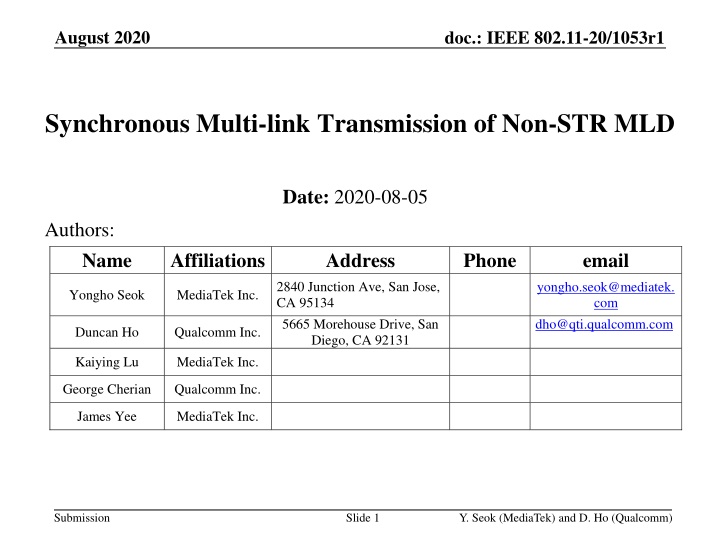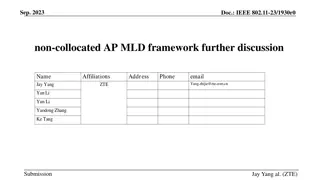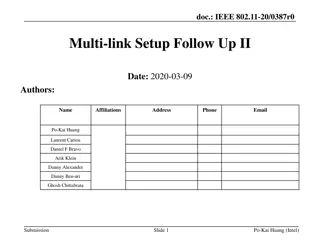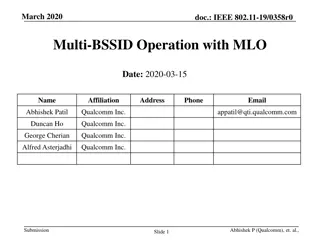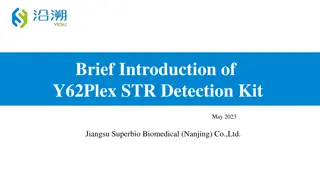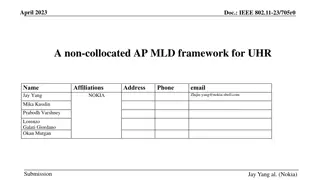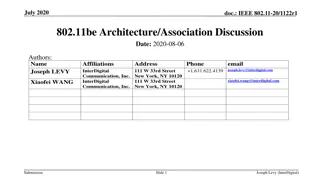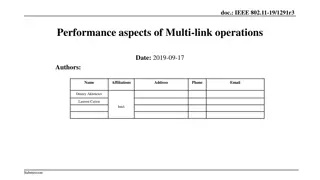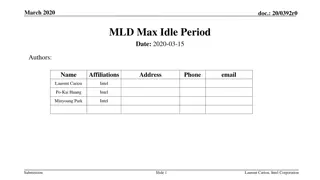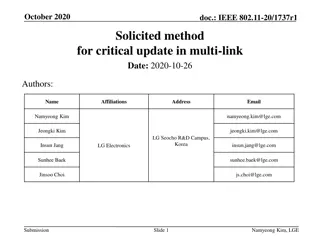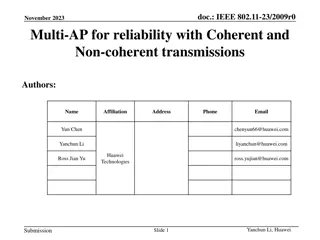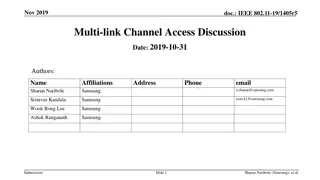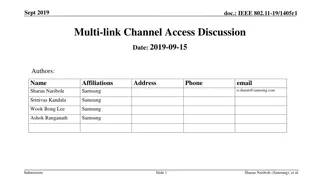Synchronous Multi-link Transmission of Non-STR MLD
The document discusses the architecture of Multi-Link Devices (MLDs) in IEEE 802.11-20/1053r1, focusing on the transmission process among affiliated STAs. It outlines the queues within MLDs and STAs, the handling of MPDUs, and the synchronization of multi-link transmission based on the RBO counter. The procedure involves passing MPDUs from MLD queue to the corresponding STA queue for efficient TXOP initiation without interference leakages.
Download Presentation

Please find below an Image/Link to download the presentation.
The content on the website is provided AS IS for your information and personal use only. It may not be sold, licensed, or shared on other websites without obtaining consent from the author.If you encounter any issues during the download, it is possible that the publisher has removed the file from their server.
You are allowed to download the files provided on this website for personal or commercial use, subject to the condition that they are used lawfully. All files are the property of their respective owners.
The content on the website is provided AS IS for your information and personal use only. It may not be sold, licensed, or shared on other websites without obtaining consent from the author.
E N D
Presentation Transcript
August 2020 doc.: IEEE 802.11-20/1053r1 Synchronous Multi-link Transmission of Non-STR MLD Date: 2020-08-05 Authors: Name Affiliations Address Phone email 2840 Junction Ave, San Jose, CA 95134 5665 Morehouse Drive, San Diego, CA 92131 yongho.seok@mediatek. com dho@qti.qualcomm.com Yongho Seok MediaTek Inc. Duncan Ho Qualcomm Inc. Kaiying Lu MediaTek Inc. Qualcomm Inc. George Cherian James Yee MediaTek Inc. Submission Slide 1 Y. Seok (MediaTek) and D. Ho (Qualcomm)
August 2020 doc.: IEEE 802.11-20/1053r1 Recap: Multi-Link Device Architecture [1,2] Multi-link device (MLD): A device that has more than one affiliated STA and has one MAC SAP to LLC, which includes one MAC data service. DS DS MLO Device Common mgmt. signaling across MLO Entity 1 and MLO Entity 2 MAC Addr (M1) MAC Addr (M2) MAC-SAP-a MAC-SAP-b MLO Entity 2 MLO Entity 1 Common BA session, SN/PN, security Common BA session, SN/PN, security STA (MAC/PHY) x STA (MAC/PHY) y STA (MAC/PHY) z WM WM WM Submission Slide 2 Y. Seok (MediaTek) and D. Ho (Qualcomm)
August 2020 doc.: IEEE 802.11-20/1053r1 Recap: Multi-Link Device Architecture [3] TX RX MAC SAP MAC SAP ADDR_A ADDR_X RX AMSDU DEFRAG DEAGG REORDER MACSEQ AMPDU FRAG BACON BACON ADDR_B EDCA0 EDCA1 ADDR_C ADDR_Y EDCA0 EDCA1 ADDR_Z PHY0 PHY1 PHY0 PHY1 Submission Slide 3 Y. Seok (MediaTek) and D. Ho (Qualcomm)
August 2020 doc.: IEEE 802.11-20/1053r1 Recap: Multi-Link Device Architecture [4] Single MAC SAP Single MAC SAP High MAC High MAC Traffic Steering Reordering Buffer Multilink Management Multilink Management Common Queues Common Queues Low MAC 1 Low MAC 1 Low MAC 2 Low MAC 2 RX Buffer RX Buffer Buffer Queues Buffer Queues Scoreboard Scoreboard EDCAF EDCAF PHY 1 PHY 2 PHY 1 PHY 2 TX 1 TX 2 RX 1 RX 2 Submission Slide 4 Y. Seok (MediaTek) and D. Ho (Qualcomm)
August 2020 doc.: IEEE 802.11-20/1053r1 Assumption STAs affiliated to an MLD independently operate and follow the baseline EDCA procedure. The MLD may have two type of queues. MLD queue: Before a transmitter among STAs affiliated to a MLD is determined, a MLD buffers the MPDUs to the MLD queue. STA queue: After a transmitter among STAs affiliated to a MLD is determined, a MLD buffers the MPDUs to the STA queue associated with the transmitter. NOTE- STA queue consists of transmit queues for each AC. Submission Slide 5 Y. Seok (MediaTek) and D. Ho (Qualcomm)
August 2020 doc.: IEEE 802.11-20/1053r1 Synchronous Multi-Link Transmission Procedure A MLD checks the RBO counter of each STA affiliated to the MLD. If the RBO counter of a STA is equal to 0, the MLD may pass the MPDU from the MLD queue to the corresponding STA queue and the STA initiates a TXOP. Synchronous multi-link transmission is not happened. AIFS TX A-MPDU 4 3 2 1 0 9 8 7 6 5 Busy (Interference leakage by STA1) Empty Nonempty STA2 Queue AIFS 4 3 4 3 2 1 0 Rx BA TX A-MPDU Busy Empty Nonempty Empty STA1 Queue MLD Submission Slide 6 Y. Seok (MediaTek) and D. Ho (Qualcomm)
August 2020 doc.: IEEE 802.11-20/1053r1 Synchronous Multi-Link Transmission Procedure However, when the RBO counter of a STA1 is equal to 0, the MLD may decide to not pass the MPDU from the MLD queue to the STA1 queue. Because the RBO counter of a STA2 almost reaches to 0. In a consequence, the STA1 does not initiates a TXOP according the baseline rule (see the next slide) and a STA2 continues the backoff procedure. 9 8 7 6 5 4 3 2 1 0 Empty STA2 Queue 4 3 2 1 0 Empty STA1 Queue MLD Submission Slide 7 Y. Seok (MediaTek) and D. Ho (Qualcomm)
August 2020 doc.: IEEE 802.11-20/1053r1 Synchronous Multi-Link Transmission Procedure In P802.11md D3.0, On these specific slot boundaries, each EDCAF shall make a determination to perform one and only one of the following functions: Decrement the backoff counter(#189). Initiate the transmission of a frame exchange sequence. Invoke the backoff procedure due to an internal collision. Do nothing. STA1 performs to do nothing because there is no frame available for transmission. At each of the above-described specific slot boundaries, each EDCAF shall initiate a transmission sequence if There is a frame available for transmission at that EDCAF, and [X] The backoff counter(#189) for that EDCAF has a value of 0, and [O] Initiation of a transmission sequence is not allowed to commence at this time for an EDCAF of higher UP. [O] Submission Slide 8 Y. Seok (MediaTek) and D. Ho (Qualcomm)
August 2020 doc.: IEEE 802.11-20/1053r1 Synchronous Multi-Link Transmission Procedure Then, when the RBO counter of the STA2 is equal to 0, the MLD passes the MPDU from the MLD queue to the STA2 queue and the STA1 queue. Both the STA2 and STA1 can initiate a TXOP simultaneously. The STA1 does not invoke a new backoff procedure if the medium is not busy according the baseline rule (see the next slide). TX A-MPDU Rx BA 9 8 7 6 5 4 3 2 1 0 Empty Nonempty STA2 Queue 4 3 2 1 0 Rx BA TX A-MPDU Empty Nonempty STA1 Queue MLD Submission Slide 9 Y. Seok (MediaTek) and D. Ho (Qualcomm)
August 2020 doc.: IEEE 802.11-20/1053r1 Synchronous Multi-Link Transmission Procedure In P802.11md D3.0, On these specific slot boundaries, each EDCAF shall make a determination to perform one and only one of the following functions: Decrement the backoff counter(#189). Initiate the transmission of a frame exchange sequence. STA1 performs to initiate a TXOP because a frame is available for transmission. Invoke the backoff procedure due to an internal collision. Do nothing. At each of the above-described specific slot boundaries, each EDCAF shall initiate a transmission sequence if There is a frame available for transmission at that EDCAF, and [O] The backoff counter(#189) for that EDCAF has a value of 0, and [O] Initiation of a transmission sequence is not allowed to commence at this time for an EDCAF of higher UP. [O] Submission Slide 10 Y. Seok (MediaTek) and D. Ho (Qualcomm)
August 2020 doc.: IEEE 802.11-20/1053r1 Synchronous Multi-Link Transmission Procedure However, if the medium of the STA1 is busy, only STA2 initiates a TXOP. The STA1 shall invoke a new backoff procedure when the medium is changed to idle according the baseline rule. But, the STA1 can dequeue the MPDU from the STA queue for retrying the synchronous multi-link transmission. TX A-MPDU Rx BA 4 3 2 1 0 Empty Nonempty STA2 Queue Empty AIFS 1 0 2 1 0 TX A-MPDU Busy Empty Nonempty STA1 Queue MLD Submission Slide 11 Y. Seok (MediaTek) and D. Ho (Qualcomm)
August 2020 doc.: IEEE 802.11-20/1053r1 Synchronous Multi-Link Transmission Procedure In P802.11md D3.0, If a STA is permitted to begin a TXOP (as defined in 10.23.2.4 (Obtaining an EDCA TXOP)) and the STA has at least one MSDU pending for transmission for the AC of the permitted TXOP, the STA shall perform exactly one of the following actions: e) Restart the channel access attempt by invoking the backoff procedure as specified in 10.23.2 (HCF contention based channel access (EDCA)) as though the medium is busy on the primary channel as indicated by either physical or virtual CS and the backoff counter(#189) has a value of 0. NOTE 1 In the case of rule e), the STA selects a new random number using the current value of CW[AC], and the retry counts(#2431) are not updated (as described in 10.23.2.8 (Multiple frame transmission in an EDCA TXOP); backoff procedure invoked for event a)). Submission Slide 12 Y. Seok (MediaTek) and D. Ho (Qualcomm)
August 2020 doc.: IEEE 802.11-20/1053r1 Observations Single MAC SAP Current backoff procedure can support a synchronous multi-link transmission. A MLD only needs a queue management for passing the MPDU from the MLD queue to STA queue, which is based on the RBO counters of STAs affiliated to the MLD and is implementation specific. High MAC Traffic Steering Multilink Management MLD Queue RBO counter RBO counter Low MAC 1 Low MAC 2 STA Queue STA Queue EDCAF EDCAF PHY 1 PHY 2 TX 1 TX 2 Submission Slide 13 Y. Seok (MediaTek) and D. Ho (Qualcomm)
August 2020 doc.: IEEE 802.11-20/1053r1 Observations Issue While several MLDs are waiting that the RBO of a link 2 reaches to 0, if the medium of the link 2 is changed to busy, they may determine to initiate a TXOP on only the link 1. Then, it may cause a collision. Submission Slide 14 Y. Seok (MediaTek) and D. Ho (Qualcomm)
August 2020 doc.: IEEE 802.11-20/1053r1 Observations Solution If the backoff counter of the STA has a value of zero, the STA may perform a new backoff procedure. 6 5 4 3 2 Busy Empty STA4 Queue 1 0 3 2 1 0 Rx BA TX A-MPDU Empty Nonempty Empty STA3 Queue MLD2 8 7 6 5 4 Busy Empty STA2 Queue AIFS 1 0 3 2 1 0 TX A-MPDU Empty Nonempty STA1 Queue MLD1 Submission Slide 15 Y. Seok (MediaTek) and D. Ho (Qualcomm)
August 2020 doc.: IEEE 802.11-20/1053r1 Conclusion In our viewpoint of the spec, we think that current backoff procedure can support a synchronous multi- link transmission. When the backoff counter of a STA affiliated to a MLD reaches zero earlier than the backoff counter of other STA affiliated to the same MLD, the STA does not transmit a MPDU and keeps its backoff counter at zero. In that way, the MLD can make to align the start time of TXOPs on each link. We just need to summarize a few key rules for the synchronous channel access based on such observation. Submission Slide 16 Y. Seok (MediaTek) and D. Ho (Qualcomm)
August 2020 doc.: IEEE 802.11-20/1053r1 References [1] https://mentor.ieee.org/802.11/dcn/19/11-19-0822-09-00be- extremely-efficient-multi-band-operation.pptx (Po-kai Huang, Intel) [2] https://mentor.ieee.org/802.11/dcn/19/11-19-0823-00-00be-multi- link-aggregation.pptx, (Abhishek Patil, Qualcomm) [3] https://mentor.ieee.org/802.11/dcn/19/11-19-1575-00-00be-multi- link-ba-operation.pptx (Matthew Fischer, Broadcom) [4] https://mentor.ieee.org/802.11/dcn/19/11-19-1921-01-00be-multi- link-architecture.pptx (Ming Gan, Huawei) [5] https://mentor.ieee.org/802.11/dcn/20/11-20-0993-00-00be-sync-ml- operations-of-non-str-device.pptx (Dmitry Akhmetov, Intel) Submission Slide 17 Y. Seok (MediaTek) and D. Ho (Qualcomm)
